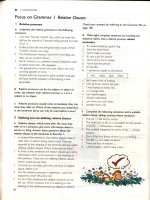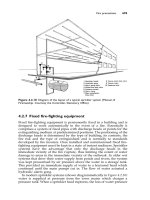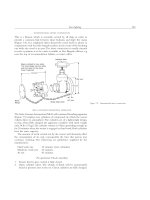Astm e 1475 13
Bạn đang xem bản rút gọn của tài liệu. Xem và tải ngay bản đầy đủ của tài liệu tại đây (109.29 KB, 7 trang )
Designation: E1475 − 13
Standard Guide for
Data Fields for Computerized Transfer of Digital
Radiological Examination Data1
This standard is issued under the fixed designation E1475; the number immediately following the designation indicates the year of
original adoption or, in the case of revision, the year of last revision. A number in parentheses indicates the year of last reapproval. A
superscript epsilon (´) indicates an editorial change since the last revision or reapproval.
scribed in Guide E94 and Practices E748, E1742, E2033,
E2445, and E2446. Many of the terms used are defined in
Terminology E1316.
1. Scope
1.1 This guide provides a listing and description of the fields
that are recommended for inclusion in a digital radiological
examination data base to facilitate the transfer of such data.
This guide sets guidelines for the format of data fields for
computerized transfer of digital image files obtained from
radiographic, radioscopic, computed radiographic, or other
radiological examination systems. The field listing includes
those fields regarded as necessary for inclusion in the data
base: (1) regardless of the radiological examination method (as
indicated by Footnote C in Table 1), (2) for radioscopic
examination (as indicated by Footnote F in Table 1), and (3) for
radiographic examination (as indicated by Footnote D in Table
1). In addition, other optional fields are listed as a reminder of
the types of information that may be useful for additional
understanding of the data or applicable to a limited number of
applications.
1.5 The values stated in SI units are to be regarded as
standard. No other units of measurement are included in this
standard.
1.6 This standard does not purport to address all of the
safety concerns, if any, associated with its use. It is the
responsibility of the user of this standard to establish appropriate safety and health practices and determine the applicability of regulatory limitations prior to use.
2. Referenced Documents
2.1 ASTM Standards:2
E94 Guide for Radiographic Examination
E748 Practices for Thermal Neutron Radiography of Materials
E1000 Guide for Radioscopy
E1255 Practice for Radioscopy
E1316 Terminology for Nondestructive Examinations
E1411 Practice for Qualification of Radioscopic Systems
E1742 Practice for Radiographic Examination
E2033 Practice for Computed Radiology (Photostimulable
Luminescence Method)
E2445 Practice for Performance Evaluation and Long-Term
Stability of Computed Radiography Systems
E2446 Practice for Classification of Computed Radiology
Systems
E2597 Practice for Manufacturing Characterization of Digital Detector Arrays
E2698 Practice for Radiological Examination Using Digital
Detector Arrays
E2737 Practice for Digital Detector Array Performance
Evaluation and Long-Term Stability
2.2 Other Standards:
ISO 12639:2004 Graphic Technology – Prepress digital data
exchange – Tag Image File Format for Image Technology
(TIFF/IT)
1.2 It is recognized that organizations may have in place an
internal format for the storage and retrieval of radiological
examination data. This guide should not impede the use of such
formats since it is probable that the necessary fields are already
included in such internal data bases, or that the few additions
can easily be made. The numerical listing and its order
indicated in this guide is only for convenience; the specific
numbers and their order carry no inherent significance and are
not part of the data file.
1.3 Current users of Guide E1475 do not have to change
their software. First time users should use the XML structure of
Table A1.1 for their data.
1.4 The types of radiological examination systems that
appear useful in relation to this guide include radioscopic
systems as described in Guide E1000, Practices E1255, E1411,
E2597, E2698 and E2737, and radiographic systems as de-
1
This guide is under the jurisdiction of ASTM Committee E07 on Nondestructive Testing and is the direct responsibility of Subcommittee E07.11 on Digital
Imaging and Communication in Nondestructive Evaluation (DICONDE).
Current edition approved July 1, 2013. Published July 2013. Originally approved
in 1992. Last previous edition approved in 2008 as E1475 – 02(2008). DOI:
10.1520/E1475-13.
2
For referenced ASTM standards, visit the ASTM website, www.astm.org, or
contact ASTM Customer Service at For Annual Book of ASTM
Standards volume information, refer to the standard’s Document Summary page on
the ASTM website.
Copyright © ASTM International, 100 Barr Harbor Drive, PO Box C700, West Conshohocken, PA 19428-2959. United States
1
E1475 − 13
TABLE 1 Field Listing
A
Field Number
Header Information:
1C,D
2C,D
3C,D
4C,D
5
6C,D
7C,D
8
9C,D
10
11C,D
12C,D
13C,D
14
15C,D
16
Examination System Description:
17
18
19
Source Section:
20C,D
21C,D
22
23
24
Image Receptor Section:
25C,D
26C,D
27
28
29C,D
Exposure Section:
30C,D
31C,D
32
33
34
35C
36C
37C
38D
Processing Section (Film/Paper):
39D
40D
41
42
43
Image Processing Description:
44C,D
45
46
47
48
49D
50
Examination Sample or Part Description:
51C
52
53C
54C
55
56C
57C
58
59C
60
Coordinate System and Scan Description:
61F
62F
63F
64F
65F
66F
Field Name and Description
Category Sets, Values and UnitsB
Intermediate file name
Format revision code
Format revision date
Source file name
Examination file description notes
Examining company/location
Examination date
Examination time
Type of examination
Other examinations performed
Operator name
Operator identification code
ASTM, ISO or other applicable standard specification
Date of applicable standard
Acceptance criteria
Notes
Alphanumeric
Alphanumeric
yyyy/mm/dd
Alphanumeric
Alphanumeric
Alphanumeric
yyyy/mm/dd
hh/mm/ss
Alphanumeric
Alphanumeric
Alphanumeric
Alphanumeric
Alphanumeric
yyyy/mm/dd
Alphanumeric
Alphanumeric
Examination system manufacturer(s)
Examination system model
Examination system serial number
Alphanumeric string
Alphanumeric string
Alphanumeric string
Radiologic source manufacturer
Radiological source model
General source description
Last calibration date
Notes on source section
Alphanumeric
Alphanumeric
Alphanumeric
Alphanumeric
Alphanumeric
string
string
string
string
string
Receptor type
Convertor type
Receptor manufacturer
Receptor model number
Notes on receptor section
Alphanumeric
Alphanumeric
Alphanumeric
Alphanumeric
Alphanumeric
string
string
string
string
string
Peak radiation energy used, or
Isotope source (use either 30 or 31)
Tube current
Radiation dosage rate
Radiation exposure time
Source-detector distance (SDD)
Source-object distance (SOD)
Image magnification of source side of examination object
Notes on exposure section
kV
Alphanumeric string
mA
mR/min
min
m
m
%
Alphanumeric string
Process description
Process method
Processor type
Processor model number
Notes on processor section
Automated or manual
Wet or dry
Alphanumeric string
Alphanumeric string
Alphanumeric string
Image processing used for image data
Image processor hardware manufacturer
Image processor hardware model
Image processor software source
Image processor software version
Pixel resolution
Notes on image processor
Alphanumeric
Alphanumeric
Alphanumeric
Alphanumeric
Alphanumeric
Pixels per cm
Alphanumeric
Sample or part name
Sample or part name description
Sample or part identification code
Sample or part material
Notes on sample or part
Number of image segments for sample
Reference standard identification
Reference standard description
Reference standard file name
Reference standard file location
Alphanumeric string
Alphanumeric string
Alphanumeric string
Alphanumeric string
Alphanumeric string
Integer number
Alphanumeric string
Alphanumeric string
Alphanumeric string
Alphanumeric string
Machine coordinate system scan axis
Machine coordinate system index axis
Machine coordinate system z-axis
Part coordinate system x-axis
Part coordinate system y-axis
Part coordinate system z-axis
Alphanumeric
Alphanumeric
Alphanumeric
Alphanumeric
Alphanumeric
Alphanumeric
2
string
string
string
string
string
string
string
string
string
string
string
string
string
string
string
string
string
string
string
string
string
string
string
string
E1475 − 13
TABLE 1
A
Field Number
67
68
69
70
71
72
73
74
Measurement Parameters:
75C
76C
77C
78C,D
79D
80C,D
81C
82C
Examination Results:
83
84
85
86
87
88
89
90
91
92
93
94
Display Settings:
95C
96E
97C
98C
99E
100E
101E
102E
103
Continued
Field Name and Description
Category Sets, Values and UnitsB
Number of object target points
Object target point number
Object target point description
Object target point x-axis
Object target point y-axis
Object target point z-axis
Description of data plane projection
Notes on coordinate system
Integer number
Integer number
Alphanumeric string
Alphanumeric string
Alphanumeric string
Alphanumeric string
Alphanumeric string
Alphanumeric string
Minimum value of data
Maximum value of data
Dynamic range resolution
Data scale
Relationship between film optical density and digital value
Dynamic range implemented
Physical spacing of the digitization interval at the image receptor
Data recording format
Integer
Integer
Number of bits
Linear, logarithmic, define scale
Alphanumeric string
Real number
Real number in [µm]
Alphanumeric string
Discontinuity location
Discontinuity description
Disposition
Notes on examination results
Image segment number
Image segment description
Image segment location
Image segment orientation
Annotation
Notes on the data (including notes on compression)
Total number of data points
Actual stream of radiologic data
Alphanumeric string
Alphanumeric string
Accept, reject or repair
Alphanumeric string
Integer number
Alphanumeric string
Alphanumeric string
Alphanumeric string
Alphanumeric string
Alphanumeric string
Integer number
Real number
Type of Display
Number of display gray values
Manufacturer of Display
Display model number
Display mode
Gray value of original image for BLACK on display
Gray value of original image for WHITE on display
Factor of gamma for scaling on display
Notes on display section
Alphanumeric string
Integer number
Alphanumeric string
Alphanumeric string
Negative (Film like) or Positive (real)
Integer number
Integer number
Real number
Alphanumeric string
A
Field numbers are for reference only. They do not imply a necessity to include all these fields in any specific database nor imply a requirement that fields used be in this
particular order.
B
Units listed first are SI; those in parentheses are inch-pound (English).
C
Denotes essential field for computerization of examination results, regardless of examination method.
D
Denotes essential field for radiographic examination.
E
Denotes essential field for images with more than 8-bit gray scale.
F
Denotes essential field for radioscopic examination.
as either a data format specifier or as a guide to the data
elements which should be included in the archival file.
ISO 8879:1986 Information Processing – Text and Office
Systems – Standard Generalized Markup Language
(SGML)
2.3 Other Documents:
Webpage for XML (Extensible Markup Language): World
Wide Web Consortium (W3C) />
3.2 Although the recommended field listing includes more
than 100 field numbers, only about half of those are regarded
as essential and are marked Footnote C in Table 1. Fields so
marked must be included in the data base. The other fields
recommended provide additional information that a user will
find helpful in understanding the radiological image and
examination result. These header field items will, in most
cases, make up only a very small part of a radiological
examination file. The actual stream of radiological data that
make up the image will take up the largest part of the data base.
Since a radiological image file will normally be large, the
concept of data compression will be considered in many cases.
Compressed data should be noted, along with a description of
the compression method, as indicated in Field No. 92 (see
Table 1).
3. Significance and Use
3.1 The primary use of this guide is to provide a standardized approach for the data file to be used for the transfer of
digital radiological data from one user to another where the two
users are working with dissimilar systems. This guide describes the contents, both required and optional for an intermediate data file that can be created from the native format of
the radiological system on which the data was collected and
that can be converted into the native format of the receiving
radiological data analysis system. This guide will also be
useful in the archival storage and retrieval of radiological data
3
E1475 − 13
5. Explanation of Fields
3.3 This guide provides a data file for a single image. It is
recognized that a complete examination record may contain
several files for the same examination method in different
areas, with or without image processing, for different examination methods, and for variations within a single method (for
example, different x-ray energies). This file will permit the
examination of a single image and will include information
about the existence of other images and records for the
examined object. This single image may be one created by
overlaying or processing results from multiple examination
approaches, for example, data fusion. For such images, the
notes sections must clearly state how the image for this file was
created.
5.1 Field Number, Name, and Description:
5.1.1 Field No. 1: Intermediate File Name—Name of the
data base file containing all of the information to follow. This
is the archive or transfer file itself.
5.1.2 Field No. 6: Examining Company/Location—The legal name/location of the company which performed the radiologic examination.
5.1.3 Field No. 9: Type of Examination—Radiographic,
radioscopic, CR, DDA, other; x-ray, gamma ray, neutron,
other.
5.1.4 Field No. 10: Other Examinations Performed—Other
NDT examinations, ultrasonic, liquid penetrant, etc.
5.1.5 Field No. 17: System Manufacturer.
5.1.6 Field No. 18: System Model—Repeat for each system.
5.1.7 Field No. 19: Serial Number—Repeat for each system.
5.1.8 Field No. 25: Receptor Type—Film/screens, image
intensifier, etc.
5.1.9 Field No. 26: Convertor Type—Lead screen, gadolinium oxysulfide screen cesium iodide scintillator, etc.
5.1.10 Field No. 29: Notes on Receptor Section—Specific
film type or other receptor.
5.1.11 Field No. 38: Notes on Exposure—Additional useful
information (for example, filtration, double-wall technique,
128 frame integration, etc.).
5.1.12 Field No. 43: Notes on Processor—Additional useful
information (for example, cycle, time/temperature data, etc.).
5.1.13 Field No. 44: Imaging Processing Used—Frame
integration (No.), edge enhancement, histogram equalization,
subtraction, etc.
5.1.14 Field No. 50: Notes on Image Processor—Additional
useful information (for example, algorithms/transforms, luminance range, etc.).
5.1.15 Field No. 55: Notes on Sample and Part—Any
service data available for the article including flight hours,
aircraft assignments, and special incidents, such as impacts,
collisions, hail storms, fires, etc.
5.1.16 Field No. 56: Number of Image Segments—If the
image of the part is accomplished in multiple physical segments.
5.1.17 Field Nos. 61 through 63: Machine Coordinate
System—Describe the coordinate system used by the original
examination equipment referenced to the radiation source. For
example, scan axis = X axis, positive down; Z axis, positive
away.
5.1.18 Field Nos. 64 through 66: Part Coordinate System—
Describe the coordinate system of the part in the scan frame.
Give the origin and unit vectors as referenced to the machine
coordinate system.
5.1.19 Field No. 74: Coordinate System Notes—Additional
information which clarifies the coordinate system or part
orientation, or both. Describe coordinates of image, for example x(plus to right), y(plus upward), z(plus into image
plane).
5.1.20 Field No. 75: Minimum Value of Data—Lower bound
of pixel intensity value for this image file, raw or processed as
the case may be, for example, 00.
3.4 The Guide E1475 data fields are assigned at the TIFF
group with Tag 50983, called Data fields of Guide E1475 using
XML as format for the data fields. The tag may be used by any
user without restrictions. The Extensible Markup Language
(XML) is a simple, very flexible text format derived from
SGML (ISO 8879). It is used to store all required information
of Guide E1475 within one TIFF Tag. Annex A1 provides more
information and an example.
4. Description of the Field Listings
4.1 Table 1 is a recommended field format for the computerized storage, retrieval and transfer of radiological image
examination data. There are three columns of information, as
indicated in 4.1.1 – 4.1.3:
4.1.1 Field Number—A reference number for ease of dealing with the individual fields within this guide. It has no
permanent value and does not become part of the data base
itself.
4.1.2 Field Name and Description—The complete name of
the field, descriptive of the element of information that would
be included in this field of the data base.
4.1.3 Category Sets, Values or Units—A listing of the types
of information which would be included in the field or the units
in which the numbers are expressed. Category sets are closed
(that is, complete) sets containing all possible (or acceptable)
inputs to the field. Values are representative sets, listing sample
(but not necessarily all acceptable) inputs to the field.
4.2 The information for reporting radiological examination
results is divided into twelve segments, as follows:
4.2.1 Header information,
4.2.2 Examination system description,
4.2.3 Source description,
4.2.4 Image receptor,
4.2.5 Exposure,
4.2.6 Processing,
4.2.7 Image processing description,
4.2.8 Examination sample or part description,
4.2.9 Coordinate system and scan description,
4.2.10 Measurement parameters, and
4.2.11 Examination results.
4.2.12 Display Settings.
4.3 Additional explanations for selected fields are given in
Section 5.
4
E1475 − 13
5.1.28 Field No. 87: Image Segment Number—Sequence
number for this segment of the image data. If the entire part is
imaged in one examination and all of this data is saved in a
single file, there will be only one image segment for the part
(and perhaps one for the reference standard).
5.1.29 Field Nos. 89 through 90: Image Segment Location
and Orientation—The location and orientation of the segment
on the part. Include the bounds on the image area described by
bounding points, lines or planes, or both.
5.1.30 Field Nos. 100 and 101: Gray Value of Original
Image for BLACK (WHITE) on Display—Gray value in full
scale original image which is transferred to the darkest
(brightest) gray value of the display—only required when the
original image has more than 8-bit gray scale.
5.1.21 Field No. 76: Maximum Value of Data—Upper limit
of pixel intensity value for this image file, raw or processed as
the case may be, for example, 127 or 255.
5.1.22 Field No. 77: Data Sample Resolution—The number
of bits to which the original data were digitized.
5.1.23 Field No. 79: Relationship Between Film Optical
Density and Digital Value—Mathematical relationship between
film density and digital value; range of density covered (0 to 4,
0.5 to 4.5, etc.).
5.1.24 Field No. 80: Dynamic Range Implemented—
Detected exposure range covered by gray scale of each pixel in
image data file. Expressed as decades of exposure latitude (1.6,
2, 4, etc.). Industrial film/screen/chemistry systems are typically 2.
5.1.25 Field No. 81: Physical Spacing of the Digitization
Interval at the Image Receptor—µm/pixel (100 µm, 80 µm, 50
µm, 25 µm, etc.).
5.1.26 Field No. 82: Data Recording Format—ASCII, numeric values or characters, Binary 16–bit in two 8-bit words,
etc.
5.1.27 Field No. 86: Notes on Examination Results—
Additional useful information (for example, custom representative accepted examined part on waiver, etc.).
6. Keywords
6.1 computed radiology; CR; data base; data fields; DDA;
data transfer; digital detector array; dynamic range; dynamic
range resolution; nondestructive testing; radiological examination; radioscopic examination; TIFF
ANNEX
(Mandatory Information)
A1. ASTM E1475 Data Fields in TIFF Image
A1.2 The structure is simple as the example shows:
A1.1 For data file exchange the Guide E1475 data fields are
assigned at the TIFF group with Tag 50983, called Data Fields
of ASTM E1475. The fields are supported in an XML structure
as shown in Table A1.1 together with example text for a DDA
inspection. The field structure can be read with a standard
browser. A parser is provided by ASTM.
<DataSet name=”ASTM E1475”>
<Category name=”Header”>
<Field name=”FileName” number=”1”>Test.tif</Field>
< ⁄ Category>
</DataSet>
5
E1475 − 13
TABLE A1.1 Field Listing in XML FormatA
<DataSet xmlns=9?ASTM1475.xsd9 name=9ASTM E14759>
<Category name=9Header9 description=”Header Information:9>
<Field id=919 name=9Filename9 description=9intermediate file name9>Drag strut 0815 4711 Segment 4.tif</Field>
<Field id=929 name=9RevisionCode9 description=9Format revision code9>E1475</Field>
<Field id=939 name=9RevisionDate9 description=9Format revision date9>2008/04/08</Field>
<Field id=949 name=9SourceFile9 description=9Source file name9>Drag strut 0815 4711 view 4</Field>
<Field id=959 name=9FileDescription9 description=9Examination file description notes9>TIFF image</Field>
<Field id=969 name=9Company/Location9 description=9Examining company/location9>Boeing/Seattle</Field>
<Field id=979 name=9Date9 description=9Examination date9>2008/09/12</Field>
<Field id=989 name=9Time9 description=9Examination time9>08/09/12</Field>
<Field id=999 name=9ExaminationType9 description=9Type of examination9>X-Ray inspection</Field>
<Field id=9109 name=9OtherExaminations9 description=9Other examinations performed9>none</Field>
<Field id=9119 name=9Operator9 description=9Operator name9>Joe Cool</Field>
<Field id=9129 name=9OperatorID9 description=9Operator identification number9>4712</Field>
<Field id=9139 name=9Standards9 description=9ASTM, ISO or other applicable standard specification9>ASTM E2422</Field>
<Field id=9149 name=9DateOfStandard9 description=9Date of applicable standard9>2005/12/09</Field>
<Field id=9159 name=9AcceptanceCriteria9 description=9Acceptance criteria9>Level II</Field>
<Field id=9169 name=9NotesOnHeader9 description=9Notes9>Reference images used</Field>
< ⁄ Category>
<Category name=9System9 description=9Examination System Description:9>
<Field id=”17” name=9Manufacturer9 description=9Examination system manufacturer(s)9>YXLON International</Field>
<Field id=9189 name=9Model9 description=9Examination system model9>Multiplex XL</Field>
<Field id=9199 name=9SerialNumber9 description=9Examination system serial number9>20080408-51-22</Field>
< ⁄ Category>
<Category name=9Rad. Source9 description=9Source Section:9>
<Field id=9209 name=9SourceManufacturer9 description=9Radiologic source manufacturer9>Comet AG</Field>
<Field id=9219 name=9SourceModel9 description=9radiological source model9>MXR160kV</Field>
<Field id=9229 name=9SourceDescription9 description=9General source description9>Standard tube 1mm Al filter</Field>
<Field id=9239 name=9CalibrationDate9 description=9Last calibration date9>20041206</Field>
<Field id=9249 name=9NotesOnSource9 description=9Notes on source section9>Diaphragm used</Field>
< ⁄ Category>
<Category name=9Image Receptor9 description=9Image Receptor Section:9>
<Field id=9259 name=9Receptor9 description=9Receptor type9>Digital Detector Array</Field>
<Field id=9269 name=9Convertor9 description=9Convertor type9>GADOX DRZ+</Field>
<Field id=9279 name=9ReceptorManufacturer9 description=9Receptor manufacturer9>Varian</Field>
<Field id=9289 name=9RecptorModel9 description=9Receptor model number9>2520E+</Field>
<Field id=9299 name=9NotesOnReceptor9 description=9Notes on receptor section9>used in static mode, 1fps</Field>
< ⁄ Category>
<Category name=9Exposure Section9 description=9Examination System Description:9>
<Field id=9309 name=9PeakEnergy9 description=9Peak radiation energy used [keV]9>160</Field>
<Field id=9319 name=9IsotopeSource9 description=9Isotope source9>None</Field>
<Field id=9329 name=9TubeCurrent9 description=9Tube current [mA]9>3.25</Field>
<Field id=9339 name=9Dosage9 description=9Radiation dosage rate [mR/min]9>0.2</Field>
<Field id=9349 name=9ExposureTime9 description=9Radiation exposure time [min]9>0.2</Field>
<Field id=9359 name=9SDD9 description=9Source detector distance [m]9>1.2</Field>
<Field id=9369 name=9SOD9 description=9Source object distance [m]9>0.6</Field>
<Field id=9379 name=9Magnification9 description=9Image magnification of source side of examination object [%]9>210</Field>
<Field id=9389 name=9NotesOnExposure9 description=9Notes on exposure section9>0.5mm Cu filter used</Field>
< ⁄ Category>
<Category name=9Process9 description=9Processing Section (Film/Paper):9>
<Field id=9399 name=9ProcessDescription9 description=9Process description [automated or manual]9> </Field>
<Field id=9409 name=9Method9 description=9Process method [wet or dry]9> </Field>
<Field id=9419 name=9ProcessorType9 description=9Processor type9> </Field>
<Field id=9429 name=9ModelNumber9 description=9Processor model number9> </Field>
<Field id=9439 name=9NotesOnProcessor9 description=9Notes on processor section9> </Field>
< ⁄ Category>
<Category name=”Image Processing9 description=9Image Processing Description:9>
<Field id=9449 name=9ImageProcessing9 description=9Image processing used for image data9>12 frames integrated, highpass filter 9x9</Field>
<Field id=9459 name=9Manufacturer9 description=9Image processor hardware manufacturer9>YXLON</Field>
<Field id=9469 name=9IPHardware9 description=9Image processor hardware model9>YXLON IMAGE PC</Field>
<Field id=9479 name=9IPSoftware9 description=9Image processor software source9>YXLON IMAGE 3500 FR</Field>
<Field id=9489 name=9SoftwareVersion9 description=9Image processor software version9>3.12</Field>
<Field id=9499 name=9Resolution9 description=9Pixel resolution [pixel per cm]9>80</Field>
<Field id=9509 name=9NotesOnIP9 description=9Notes on image processor9>Offset and gain correction at 160kV, gamma scaling 0.45</Field>
< ⁄ Category>
<Category name=9Part description9 description=9Examination Sample or Part Description:9>
<Field id=9519 name=9PartName9 description=9Sample or part name9>Drag strut</Field>
<Field id=9529 name=9NameDescription9 description=9Sample or part name description9>from outboard strut</Field>
<Field id=9539 name=9PartID9 description=9Sample or part identification code9>0815-4711</Field>
<Field id=9549 name=9Material9 description=9Sample or part material9>AL 6061</Field>
<Field id=9559 name=9NotesOnPart9 description=9Notes on sample or part9>strut of revision 2</Field>
<Field id=9569 name=9ImageSegments9 description=9Number of image segments for sample9>8</Field>
<Field id=9579 name=9ReferenceID9 description=9Reference standard description9>ASTM E2422</Field>
<Field id=9589 name=9ReferenceDescription9 description=9Reference standard description9>Aluminum casting reference images - level II</Field>
<Field id=9599 name=9ReferenceFileName9 description=9Reference standard file name9>ASTM E2422_SC_130um.tif</Field>
6
E1475 − 13
TABLE A1.1
Continued
<Category Name=”Coordinate System9 description=9Coordinate System and Scan Description:9>
<Field id=9619 name=9ScanAxis9 description=9Machine coordinate system scan axis”>scan axis9>scan axis = X-axis from focal spot to
detector positive< ⁄ Field>
<Field id=9629 name=9IndexAxis9 description=9Machine coordinate system index axis9>index axis = Y-axis perpendicular to X-axis; left position</Field>
<Field id=9639 name=9Z_Axis9 description=9Machine coordinate system Z-axis9>Z-axis perpendicular to X-axis; from top down positive</Field>
<Field id=9649 name=9Part_X_Axis9 description=9Part coordinate system x-axis9>0,1,0</Field>
<Field id=9659 name=9Part_Y_Axis9 description=9Part coordinate system y-axis9>1,0,0</Field>
<Field id=9669 name=9Part_Z_Axis9 description=9Part coordinate system z-axis9>0,0,1</Field>
<Field id=9679 name=9TargetPoints9 description=9Number of object target points9>5</Field>
<Field id=9689 name=9PointNumber9 description=9Object target point number9>2</Field>
<Field id=9699 name=9PointDescription9 description=9Object target point description9>Center eye</Field>
<Field id=9709 name=9Point_X_Axis9 description=9Object target point x-axis9>70</Field>
<Field id=9719 name=9Point_Y_Axis9 description=9Object target point y-axis9>70</Field>
<Field id=9729 name=9Point_Z_Axis9 description=9Object target point z-axis9>70</Field>
<Field id=9739 name=9ProjectionDescription9 description=9Description of data plane projection9> </Field>
<Field id=9749 name=9NotesOnCoordinateSystem9 description=9Notes on coordinate system9>Origin of part [X, Y, Z]: (420, 360, 540)</Field>
< ⁄ Category>
<Category name=9Measurement9 description=9Measurement Parameters:9>
<Field id=9759 name=9MinimumValue9 description=9Minimum value of data9>0</Field>
<Field id=9769 name=9MaximumValue9 description=9Maximum value of data9>65535</Field>
<Field id=9779 name=9BitResolution9 description=9Dynamic range resolution9>16</Field>
<Field id=9789 name=9DataScale9 description=9Data scale9>linear</Field>
<Field id=9799 name=9OpticalDensity9 description=9Relationship between film optical density and digital value9> </Field>
<Field id=9809 name=9DynamicRange9 description=9Dynamic range implemented9>3.2</Field>
<Field id=9819 name=9Spacing9 description=9Physical spacing of the digitization interval at the image receptor9>127.0</Field>
<Field id=9829 name=9RecordingFormat9 description=9”Data recording format9> 16 Bit binary</Field>
< ⁄ Category9
<Category name=”Results9 description=9Examination Results:9>
<Field id=9839 name=9Location9 discription=9Discontinuity location9>Edge of the eye</Field>
<Field id=9849 name=9Description9 description=9Discontinuity description9>Shrinkage cavity</Field>
<Field id=9859 name=9Disposition9 description=9Disposition9>Accept</Field>
<Field id=9869 name=9NotesOnResults9 description=9Notes on examination results9>Discontinuity below Level 1: accepted</Field>
<Field id=9879 name=9SegmentNumber9 description=9Image segment number9>4</Field>
<Field id=9889 name=9SegmentDescription9 description=9Image Segment description9”>view 4 of 8</Field>
<Field id=9899 name=9SegmentLocation9 description=9Image segment location9”>upper end of drag strut</Field>
<Field id=9909 name=9SegmentOrientation9 description=9Image segment oreintation9>in Y/Z plane</Field>
<Field id=9919 name=9Annotation9 description=9Annotation9>none</Field>
<Field id=9929 name=9NotesOnData9 description=9Notes on the data - including notes on compression9>uncompressed TIFF image</Field>
<Field id=9939 name=9DataPoints9 description=9Total number of data points9>2949120</Field>
<Field id=9949 name=9ActualStream9 description=9Actual stream of radiologic data9> </Field>
< ⁄ Category>
<Category name=”Display9 description=9Display Settings:9>
<Field id=9959 name=9DisplayType9 description=9Type of Display9>TFT Display</Field>
<Field id=9969 name=9DisplayValues9 description=9Number of display gray values9>256</Field>
<Field id=9979 name=9DisplayManufacturer9 description=9Manufacturer of Display9>IIYAMA</Field>
<Field id=9989 name=9DisplayModel9 description=9Display model number9>ProLite B2403WS</Field>
<Field id=9999 name=9DisplayMode9 description=9Display mode [Negative (Film like) or Positive (real)]9>Positive</Field>
<Field id=91009 name=9LowestGrayValue9 description=9Gray value of original image for BLACK on display9>2450</Field>
<Field id=91019 name=9HighestGrayValue9 description=9Gray value of original image for WHITE on display9>27500</Field>
<Field id=91029 name=9Gamma9 description=9Factor of gamma for scaling on display9>0.45</Field>
<Field id=91039 name=9NotesOnDisplay9 description=9Notes on display section9>calibrated display, last calibration 2008/06/12</Field>
< ⁄ Category>
</DataSet>
A
Fields which are not used should not be written into the file. They are in Table A1.1 for completeness only.
ASTM International takes no position respecting the validity of any patent rights asserted in connection with any item mentioned
in this standard. Users of this standard are expressly advised that determination of the validity of any such patent rights, and the risk
of infringement of such rights, are entirely their own responsibility.
This standard is subject to revision at any time by the responsible technical committee and must be reviewed every five years and
if not revised, either reapproved or withdrawn. Your comments are invited either for revision of this standard or for additional standards
and should be addressed to ASTM International Headquarters. Your comments will receive careful consideration at a meeting of the
responsible technical committee, which you may attend. If you feel that your comments have not received a fair hearing you should
make your views known to the ASTM Committee on Standards, at the address shown below.
This standard is copyrighted by ASTM International, 100 Barr Harbor Drive, PO Box C700, West Conshohocken, PA 19428-2959,
United States. Individual reprints (single or multiple copies) of this standard may be obtained by contacting ASTM at the above
address or at 610-832-9585 (phone), 610-832-9555 (fax), or (e-mail); or through the ASTM website
(www.astm.org). Permission rights to photocopy the standard may also be secured from the Copyright Clearance Center, 222
Rosewood Drive, Danvers, MA 01923, Tel: (978) 646-2600; />
7









